Comparing EPD Data Standards, and an opinion on the way forward
Introduction to EPD Data & the Standards conundrum
Environmental Product Declarations (EPDs) serve as essential guides in the construction industry, providing detailed insights into the environmental footprint of building materials. Much like how nutrition labels help consumers understand what’s in their food, EPDs help professionals make informed, sustainable choices for their projects.
However, when it comes to standardizing these declarations, the situation becomes unexpectedly complex. While “standardization” suggests a straightforward format, we often find ourselves in a labyrinth of options (and formats…).
While the intention behind having standards is to streamline and clarify, the reality is a growing collection of guidelines, each with its own benefits, downsides, nuances, etc.
Despite the confusion, these standards are crucial for advancing sustainability in construction, even if navigating them can feel like solving a puzzle.
Ok… so which single standard do we follow?
The proliferation of standards often stems from a well-intentioned yet somewhat cyclical pattern. Organisations examine an existing standard and, spotting what they perceive as gaps or shortcomings, decide the best course of action is to create a new one.
This iterative process, while aimed at improvement, often leads to a landscape brimming with standards, each slightly different from the last, reflecting the diverse perspectives and priorities of their creators.
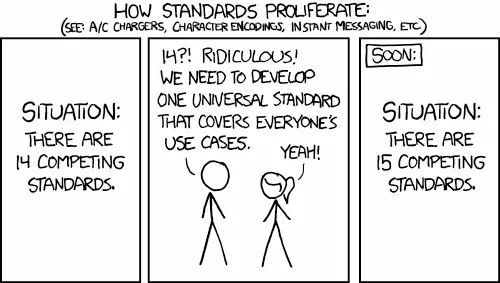
Source: https://xkcd.com/927/
What standards exist today (2024) for EPD data?
Let’s have a look at the landscape…
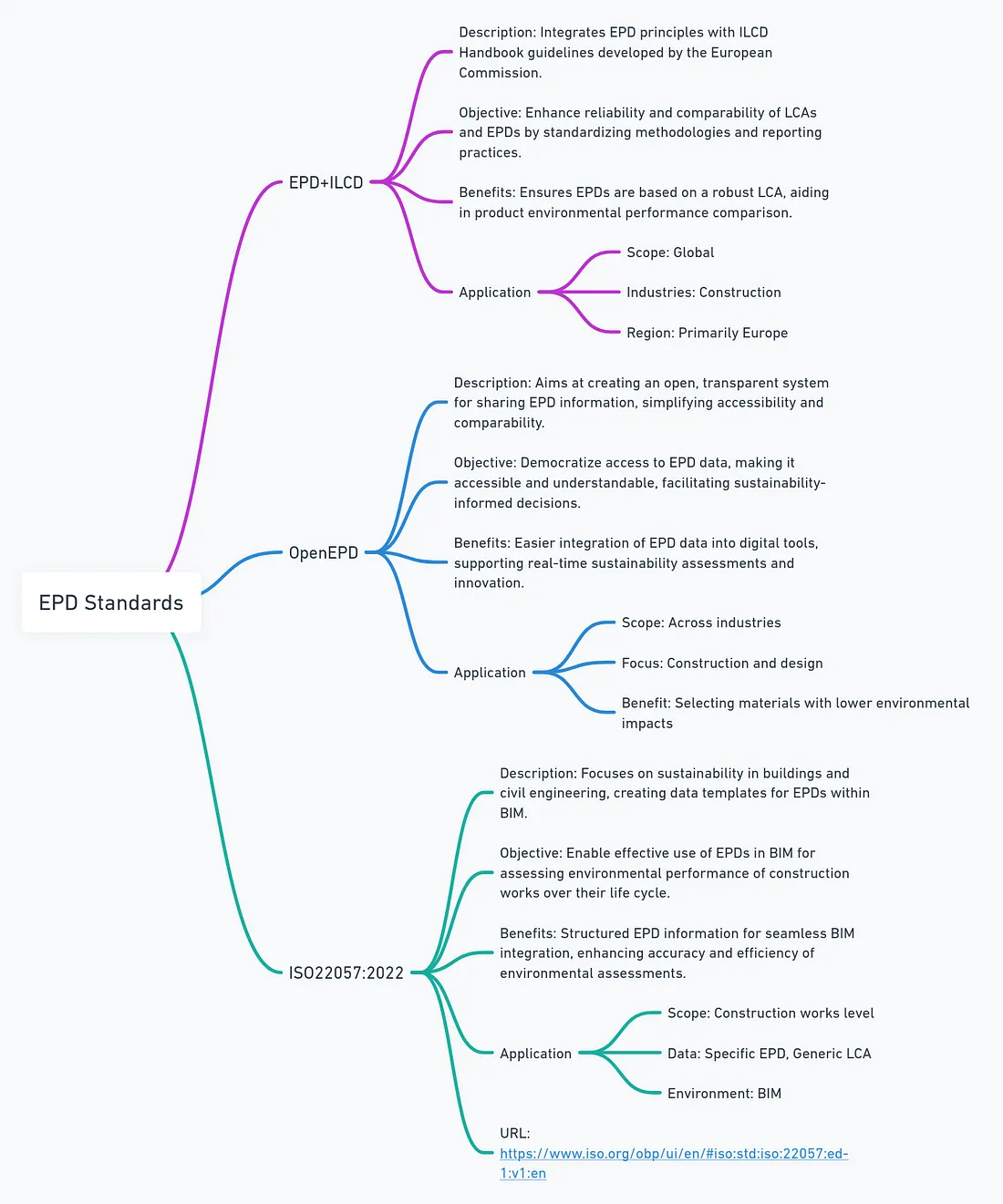
EPD+ILCD
EPD+ILCD integrates the principles of Environmental Product Declarations (EPD) with the International Reference Life Cycle Data System (ILCD) Handbook guidelines. The ILCD was developed by the European Commission to provide a common basis for consistent, robust, and quality-assured life cycle assessments (LCAs).

- Objective: To enhance the reliability and comparability of life cycle assessments and EPDs by standardizing methodologies and reporting practices.
- Benefits: It ensures that EPDs are based on a robust and comprehensive LCA, making it easier for decision-makers to compare the environmental performance of products.
- Application: Primarily used in Europe, its methodology is applicable globally, across various industries including construction, to assess the environmental impacts of products throughout their life cycle.
OpenEPD
OpenEPD is a relatively new approach aimed at creating an open and transparent system for sharing EPD information. It focuses on simplifying the accessibility and comparability of EPDs.
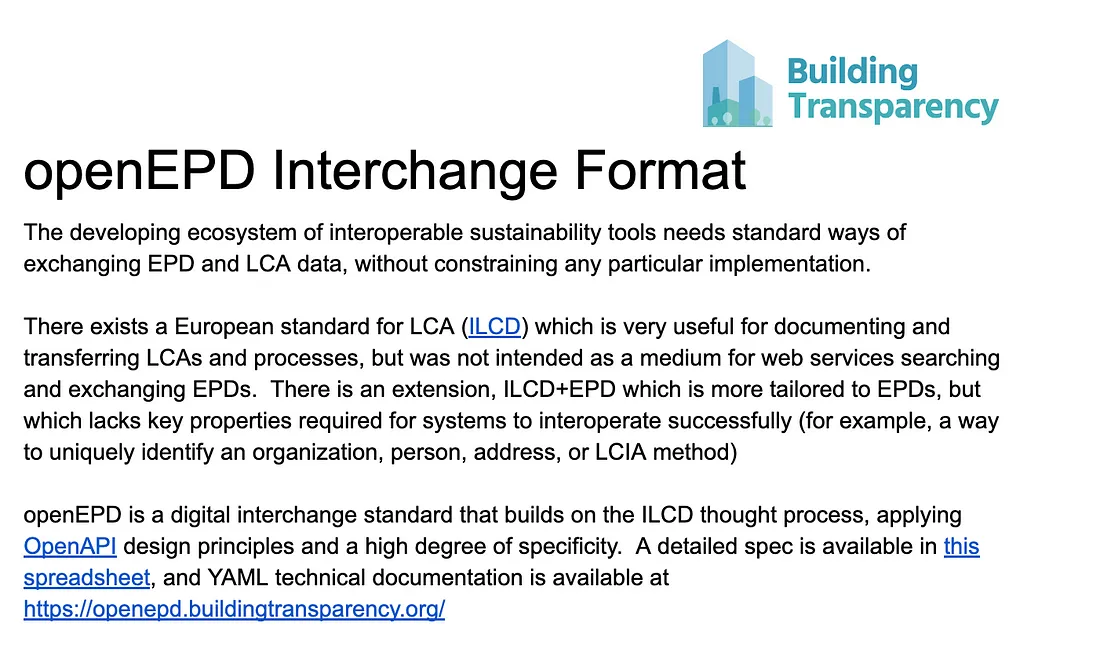
- Objective: To democratize access to EPD data by making it more accessible and understandable for a wider audience, facilitating better-informed decisions regarding sustainability.
- Benefits: Enables easier integration of EPD data into digital tools and platforms, supporting sustainability assessments in real-time and fostering innovation in sustainable product development.
- Application: Although applicable across industries, it’s particularly beneficial in construction and design, where selecting materials with lower environmental impacts is crucial.
ISO 22057:2022 Overview
ISO 22057:2022 is focused on sustainability in buildings and civil engineering works, specifically on creating data templates for the use of Environmental Product Declarations (EPDs) for construction products within Building Information Modelling (BIM).

- Objective: The standard aims to enable environmental and technical data provided in EPDs for construction products to be used effectively within BIM to assist in assessing the environmental performance of construction works over their life cycle.
- Benefits: By structuring EPD information using data templates to make it machine-interpretable, ISO 22057:2022 ensures that EPD data can be seamlessly integrated into BIM processes. This approach enhances the accuracy and efficiency of environmental performance assessments, facilitating informed decision-making in the construction sector.
- Application: The standard is applicable to the structuring of both specific EPD and generic LCA data within a BIM environment. This dual applicability ensures that in the absence of specific EPD data, generic LCA data can still enable the assessment of environmental performance at the construction works level.
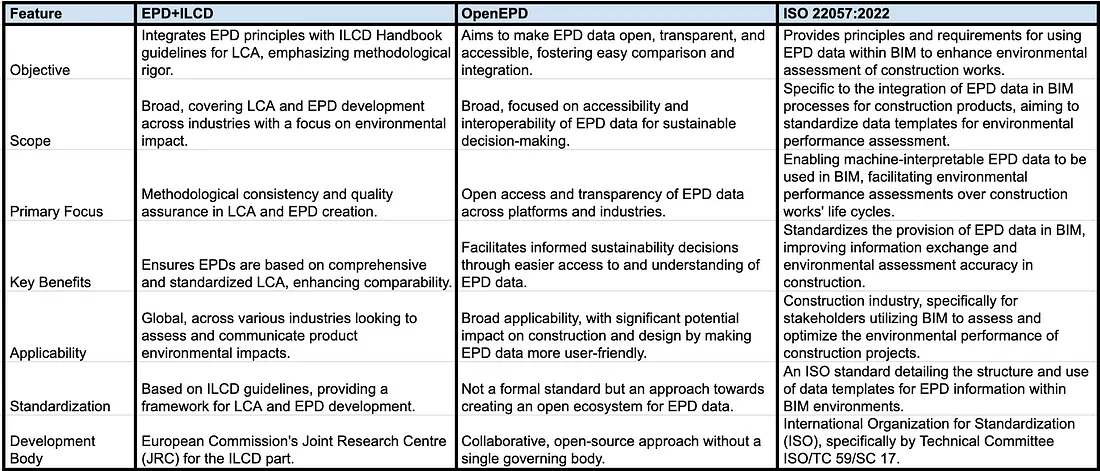
Comparison and Interoperability:
- EPD+ILCD and OpenEPD focus on the broader aspect of environmental declarations, with EPD+ILCD emphasizing the quality and rigor of life cycle assessments (LCAs) and EPDs, and OpenEPD promoting the accessibility and transparency of EPD data.
- ISO 22057:2022 complements these initiatives by providing a framework for incorporating EPD and LCA data into BIM. Rather than focusing solely on the carbon footprint, it addresses a broader range of environmental impacts by facilitating the standardized, machine-interpretable provision of EPD data for use in BIM. This enables a more comprehensive environmental assessment of construction projects.
- Interoperability among these standards and initiatives is critical for advancing sustainable construction practices. ISO 22057:2022 plays a pivotal role by ensuring that EPD data can be effectively integrated into BIM workflows, enhancing the environmental assessment capabilities within the construction industry. This interoperability supports a more holistic approach to sustainability in the built environment, leveraging the strengths of each standard to facilitate improved environmental performance across the lifecycle of construction works.
What is each of them good for?
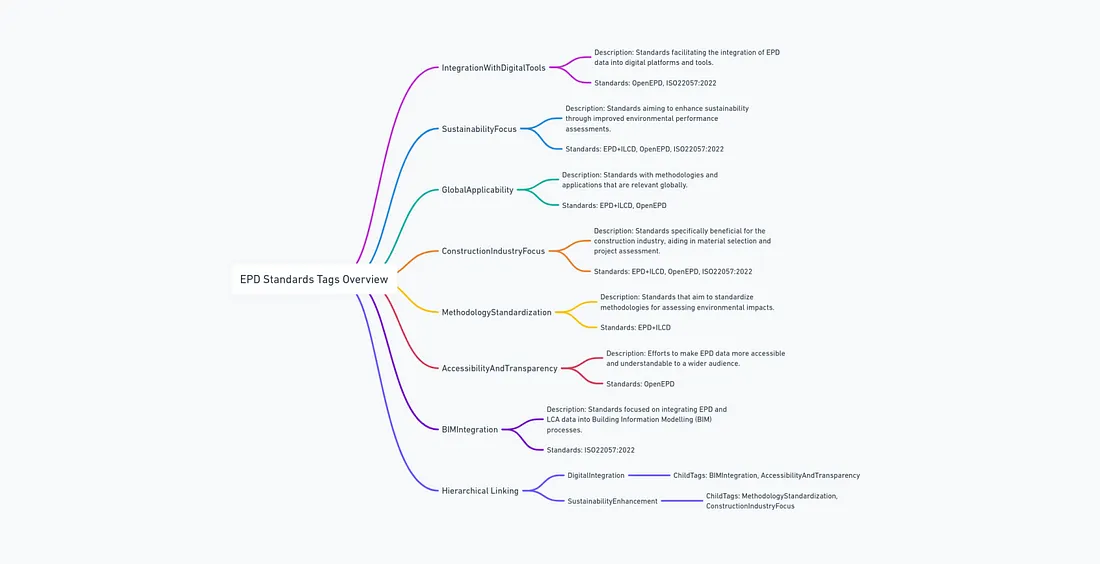
In the landscape of Environmental Product Declarations (EPDs), various standards play pivotal roles in defining, measuring, and communicating the environmental impacts of products and systems.
Among these, the EPD+ILCD standard, developed under the guidance of the European Commission, stands out for its integration of EPD principles with the International Reference Life Cycle Data System (ILCD) Handbook guidelines. This standard is particularly useful for enhancing the reliability and comparability of Life Cycle Assessments (LCAs) and EPDs. By standardizing methodologies and reporting practices, it ensures that EPDs are based on a robust LCA framework, aiding in the accurate comparison of product environmental performances. Its application is especially relevant in the global sphere, with a pronounced emphasis on the construction industry, aiming to improve sustainability practices and decisions across borders.
The OpenEPD standard emerges as a beacon for transparency and accessibility in the realm of environmental declarations. It aims to democratize access to EPD data, making it accessible and understandable, thereby facilitating informed decisions regarding sustainability. This standard is invaluable for its potential to simplify the integration of EPD data into digital tools, supporting real-time sustainability assessments and fostering innovation across various industries. With a particular focus on the construction and design sectors, OpenEPD encourages the selection of materials and processes with lower environmental impacts, showcasing its commitment to environmental stewardship and the promotion of sustainable development practices.
ISO22057:2022 represents a significant advancement in the integration of sustainability within the building and civil engineering domains. This standard focuses on creating data templates for EPDs within Building Information Modelling (BIM) systems, enabling the effective use of EPDs in assessing the environmental performance of construction works throughout their life cycle. By providing structured EPD information for seamless BIM integration, ISO22057:2022 enhances the accuracy and efficiency of environmental assessments, making it an essential tool for professionals in the construction industry. This standard underscores the importance of leveraging digital technologies to improve sustainability outcomes, illustrating the evolving nature of environmental standards in adapting to new challenges and opportunities in the field of sustainable construction.
Opinion: Where do we go from here?
In the realm of sustainability data and Environmental Product Declarations (EPDs), we’ve encountered a paradox. Standards, intended to simplify and clarify, have instead woven a tapestry of complexity in an already intricate domain.
It’s as if every time someone says, “Let’s make this easier to understand,” a new standard pops up.
So, where do we go from here?
The natural inclination might be to call for a halt to the creation of new standards. But is that the answer?
Instead, let’s embrace the chaos with a touch of ingenuity. The beauty of our current technological era is our ability to harness powerful tools like AI to sift through, make sense of, and unify disparate pieces of information.
Imagine a world where, instead of wringing our hands over the proliferation of standards, we let standard-creators run wild, while we deploy AI transformers and aggregators to marshal the data into coherence. These agents could ingest and transform EPD data from any format into exactly what you’re looking for.
2050 Materials’ EPD Data
At 2050 Materials, we have an API with millions of data points derived from EPDs. Our “standards” approach is to find the union of all the sources we ingest, and to offer the most practical format we can think of. However, we’re not stopping there.
We are continuously building libraries and transformers to be able to turn any standard of data (existing, or the ones to be inevitably developed in the future) into value, by providing only the answer you need.
If you’re curious about our API, you can generate a token here for free, and get started with our tutorials here.
Sources
ISO: https://www.iso.org/obp/ui/en/#iso:std:iso:22057:ed-1:v1:en
Building Transparency: https://www.buildingtransparency.org/
Eco Platform: https://www.eco-platform.org/home.html
Related articles

Climate-Resilient Materials for the Built Environment: A Data-Centred Prime
As climate volatility intensifies, resilience metrics are fast becoming as critical as carbon data in material selection. This article outlines why adaptation is now a design imperative, how materials can be evaluated through a systems lens, and what KPIs project teams should demand. From self-healing concrete to fire-rated façades, we present a structured taxonomy of resilient materials, explain how to embed this intelligence into digital design workflows, and propose next steps for specification, benchmarking, and procurement.
Read more
The Most Interesting Low Carbon Products in Office Design
In this article and collection, we highlight 11 outstanding products that contribute to a lower carbon footprint in office design.
Read more
Top Low Carbon Building Boards: Performance, Benefits, and Use Cases
The building boards highlighted in this article and collection showcase low-carbon innovation in modern construction.
Read more